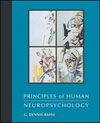If language is a uniquely human capacity, the ability to orient and direct movement in space is essential for the survival of all but the simplest of animals and must have emerged very early in the course of evolution. Consistent with these differences, the modes of cognition mediating language and spatial processing are strikingly different. The mental representations underlying language are symbolic representations. For example, a word is a sound or a written pattern that does not usually bear any direct relationship to the thing that it denotes (although certain poetic uses of words such as buzz or hiss strive toward such a relationship, a literary device called onomatopoeia). We all know the object to which the word moon refers, although there is nothing intrinsic to that word that has anything to do with the natural satellite that circles the earth each month. In contrast to this symbolic function, a mental representation may capture some of the actual characteristics of (and thus be analogous to) that which it represents. For example, the moon could be represented by a circle. Such representations are termed analogical representations. Mental representations of space, such as an image of the layout of furniture in a familiar room or the relative locations of cities on a map, are analogical, although the content of these images could be represented symbolically in the form of a verbal description or coordinates of latitude and longitude. Actually this distinction is not quite as clear-cut as it appears. It is well known that mental images are not veridical (true) representations of the external world. This is clear to most people who, having been asked to form an image of, say, the Parthenon, are then asked how many pillars line its facade. Although a small minority of people are able to form completely veridical images, termed eidetic images, most of us form images that contain far less information than a photograph. In fact, our mental representations of spatial relationships are strongly influenced by our symbolic or conceptual understanding of the world. A dramatic illustration of this is the finding that, when asked to imagine a map of the United States and then imagine the locations of Reno and San Diego, subjects tend to visualize Reno as lying east of San Diego because they believe this to be the case (Stevens & Coupe, 1978). In fact, Reno lies west of San Diego. As we will see, the fact that spatial information can be coded in multiple ways and is subject to multiple influences complicates attempts to understand its underlying neural basis. |



 2002 McGraw-Hill Higher Education
2002 McGraw-Hill Higher Education